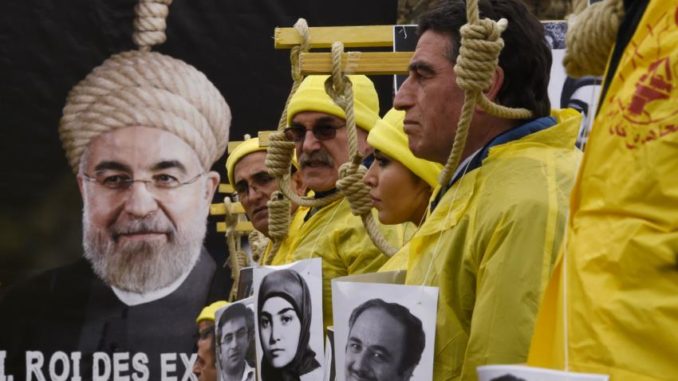
In its recent report, the international human rights group, Amnesty International said Iran under the mullahs, with 507 registered executions in 2017, is responsible for more than half of the world’s executions, saying “more than half (51%) of all recorded executions in 2017 were carried out in Iran.”
In this report, Amnesty provides horrifying numbers from four different prisons regarding individuals on death row:
1. Rajaie Shahr (Gohardasht) Prison in Karaj
Around 264 inmates are held in ward 10 of this prison, of which 86 are on death row, meaning one third.
Onward 3, known as the youth ward, with around 180 inmates under the age of 25, around 80 are currently on death row condemned for “retribution in kind.” A number of these individuals were arrested under the age of 18.
This accumulates to nearly half of the youth ward and one-third of ward 10 are inmates on death row.
Inward 3 nearly 120 of the 210 inmates are on death row. This is more than half.
Inward 2, known as the Dar Al Quran ward, 120 of the 160 inmates are condemned based on “retribution” charges.
2. Qezel Hessar Prison in Karaj
Unit 2 of this prison has around 1,000 death row inmates, with numerous individuals charged with murder and others for drug offenses.
3. Urmia Prison
Inwards 1 to 4 of this jail more than 113 individuals are currently on death row. All the while this may not be the latest numbers.
Wards 1 and 2 of this prison, specified for mentally disturbed inmates, eight individuals are on death row.
Ward 12 is also home to three death row inmates.
The so-called youth ward houses six individuals condemned to execution.
Ward 15, known as the drug offenses ward, six individuals are known to be on death row.
4. Zahedan Prison
According to the latest list of names rounded up in March, 136 inmates are on death row. Some of which have been held in the horrendous conditions of this jail for years awaiting their execution. Drug criminals and a number of political prisoners are seen among the death row inmates.
24 individuals in ward 4 of this prison are on death row, mostly for drug-related charges, murders or affiliation to political groups.
Wards 1 and 3 of this prison houses another 21 death row inmates.
This report has been accumulated from only four prisons in Iran.
It is worth noting that these numbers do not include the execution of political prisoners, opposition members, and recent protesters. In addition, more than 30,000 political prisoners were executed in the 1988 massacre and to this day the Iranian regime has sent over 120,000 people to the gallows.
Taking a closer look, especially on the issue of drug-smuggling, Iranian regime parliament speaker Ali Larijani provided these remarks in response to a question about the high number of executions in Iran back in 2014.
“Nearly 80% of all executions in Iran are due to this country’s intense fight against narcotics,” according to the state-run Mashreq daily.
However, senior Iranian regime officials has time and again recognized the fact that drug smuggling in Iran is controlled by the various military, intelligence and diplomatic circles, with the Revolutionary Guards (IRGC) and Quds Force topping the list. These entities are directly involved in procuring and distributing drugs not only across Iran but through a vast international network involved in procuring and transiting narcotics, resulting in netting billions of dollars in revenue.
“The IRGC uses its own specific logistics for this smuggling ring, being shipping lines and airliners, providing it unlimited authority and power,” according to the RFI Farsi back in November 2011.
“Italian sources revealed recently how this country has been able to identify a network linked to the IRGC Quds Force involved in managing a number of drug networks transiting narcotics into the European Union,” according to the state-run Siyasat daily in April of last year.
It is quite clear that this number of murders and crimes resulting in Iran having more than half of the world’s executions don’t fall in line with the enormous natural wealth and economic resources available in this country. A wealthy nation will never fall to the low of having such a high number of criminals accused of murder and 50 individuals entering the country’s prisons every hour. This figure was provided by Iran’s Social Security Association chief to the BBC website in May of last year.
As a result, the roots of these crimes go back to the very regime ruling this country, in which “80 to 90 percent of the people are living in poverty,” according to Etela’at daily in January 2014.
One main motive behind these executions must also be taken into consideration: the Iranian regime needs to continue its crackdown machine and create a climate of fear among the populace. One certain medium is through daily executions.
Indeed, the mullahs’ regime has remained in power through such a policy of executions and domestic repression but not for so long. Recent uprising and widespread protests across the country may very well proof fatal to the regime and ring the bell for the end of the regime.
Following the December/January uprising in Iran, the late Asma Jahangir, former United Nations Special Rapporteur on Human Rights in Iran, said the Iranian regime cannot continue this trend of creating fear and horror among its people.

